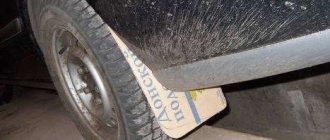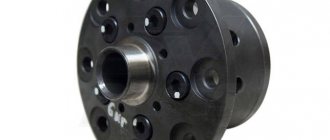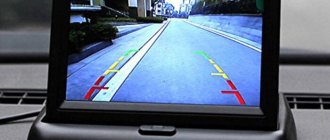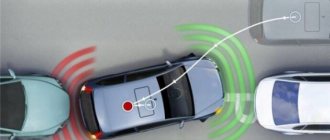Tuning is an update of factory settings at the request of the car owner, for example, increasing engine power, increasing the efficiency of the braking system, upgrading the suspension, increasing ground clearance, leather seat upholstery, changing the exterior and interior of the car. Pajero is an SUV from. The vehicle has high cross-country ability and a pleasant appearance, which is why it is popular all over the world. In 2006, the first Mitsubishi Pajero Wagon 4 cars were released, some changes were made in 2012, and then in 2014 in its restyling, this concerned external parts such as the bumper and grille. Spare parts for new Pajero Wagon IV models are also suitable for older models.
- Body kits for Pajero 4
- Interior tuning Door trim
- Ceiling
- Armrests
- Speaker podiums
- Steering wheel
- Pedals
- Console
- Radiator grilles
Maneuvers open and hidden
The consequences of the next restyling of the Mitsubishi Pajero IV are barely visible to the naked eye.
To see the difference more clearly, we placed next to it a pre-restyling car prepared by the 4X4 Tuning Center team. It also looks standard, only professionals will notice the difference. It remains only to recall that the Pajero is sold with three types of engines: two petrol V6s of 3.0 and 3.8 liters with a capacity of 178 and 250 horsepower, respectively, and one in-line four-cylinder turbodiesel of 3.2 liters with two hundred “horses” under the hood. Diesel is perhaps the best option for this SUV, so we took it for a test and immediately went to the 4x4 Tuning Center , where a similar, but pre-restyling car was already waiting for us
Despite the completely independent suspension, the Pajero has sufficient cross-country ability, it is spacious, reliable, and the famous Super Select transmission allows you to use all-wheel drive both off-road and on asphalt without fear of “breaking” the transmission. To save fuel, the front axle can be disabled on a dry road, and in winter you can drive in 4x4 mode with a free center differential, locking it only when necessary. Low gearing, standard 100% locking of the rear axle, a five-speed automatic transmission, which makes it easier to control traction than with a manual gearbox - the Padzherik is not without reason popular as an expedition vehicle.
While losing in cross-country ability to such monsters as the LR Defender and Jeep Wrangler Rubicon Unlimited, it is significantly ahead of them in comfort and is indispensable on routes with large asphalt stretches and moderate off-road sections. For such trips there is no need to hang several hundredweight of power bumpers, and it is becoming more and more difficult to legalize changes in the design every year, so it is better if the tuning is invisible, but as functional as possible.
Engine Mitsubishi Pajero 2
If at first the Pajero-2 was equipped with only two types of internal combustion engines, then later the line of power units expanded significantly, and over the entire existence of the model the following gasoline engines were installed:
- 2.5-liter 4G54 – 8-cl. /103 l. With. (this engine was also installed on Pajero-1);
- 2.4-liter 4G64 – 8-cl. /112 l. With.;
- 3-liter 6G72 – 12-cl. /150 l. With. and 24-cl. /181 l. With.;
- 3.5-liter 6G74 – 12-cl. /194 l. With. and 24-cl. /208 l. With.;
- 3.5-liter 6G74 GDI – 24-cl. /245 l. With.;
- 3.5-liter 6G74 MIVEC – 24-cl. /280 l. With.
You can easily determine whether a Mitsubishi has a 4- or 6-cylinder gasoline engine by the model name - the very first digit indicates the number of cylinders.
The range of Mitsubishi Pajero 2 diesel engines is much more modest - there are only three types of internal combustion engines:
- 2.5-liter 4D56 – 8-cl. /105 l. With.;
- 2.8-liter 4M40 – 8-cl. /125 l. With.;
- 2.8-liter 4M40 EFI – 8-cl. /140 l. With.
The brand of turbocharged diesel engine 4M40 EFI differs from the 4M40 in the presence of electronic fuel injection pump control.
Confrontation
First of all, they “pushed” the cars nose to nose – you can immediately see how much the ground clearance of the prepared car has increased. To “stick” the evil Mickey Thompson LT 275/77R18 BAJA ATZ P3 tires into the standard wheel arches instead of the standard 265/60R18 tires, a suspension lift was needed. A set of reinforced springs and shock absorbers Old Man Emu added about 40 millimeters to the already good ground clearance of 225 mm.
Pajero has its own protection for the engine and fuel tank , so the work under the bottom ended with the installation of transfer case protection made of composite material. A powerful OFF-ROAD MASTER 12,000 winch with a Kevlar cable and hawse was “embedded” into the standard front bumper. Everything is done so carefully that you won’t immediately notice: the fairlead and the cable hook do not protrude from the bumper, and you can use the winch without removing the license plate.
The Safari snorkel protects the motor from water and dust. To install it, according to the instructions, you need to dismantle the standard washer reservoir and install the supplied one, of a smaller capacity, without a headlight washer pump. I had to go my own way - to install a large “Zhiguli” tank under the hood, cutting into it an additional “sprayer”.
The hood opens and is held in place with the help of hydraulic stops, Pro Bright DRL-01 diode daytime running lights were installed in the standard headlight sections under the position lamp base, and Pro Bright RL-01 diode reversing lamp modules were installed in the rear optical elements. A CB radio with an antenna on the spare tire bracket, a tow hook, a compact two-meter ARB awning mounted on standard luggage rails - these are all the visible changes.
Without waiting for restyling, the tuners themselves glued the car with an additional layer of sound insulation, and instead of a sensor for automatically switching from high to low beam, they installed a thermal imager! This original contraption cost almost half the construction budget, but it’s worth it. A special camera installed in the radiator grille under the “three diamonds” “sees” and frames objects emitting heat - people on the side of the road, animals crossing the road or standing on the steppe dirt road at night. At the same time, the thermal imager will not blind anyone, you can turn off the external lighting altogether, everything alive and warm in front of the car will still not go unnoticed. The image is transmitted to the display of the standard media system.
Interior modification option
The interior of Mitsubishi Pajero Sport cars of the first three generations is thought out to the smallest detail. But if the upholstery is worn out or tired, it should be replaced. The work is quite difficult, especially when it comes to removing the factory upholstery. Each part is peeled separately.
They purchase new finishing material. The most popular is Alcantara. It is durable and does not fade. Easy to clean stains and dirt. It is valued for its ability to maintain a constant temperature in winter and summer.
The trim begins with the front doors. Then they move on to the rear, ceiling and trunk. This procedure takes quite a lot of time. They cut out according to the old parts, leaving allowances along the edges. Cut holes for handles, speakers, and window regulators.
The wiring is hidden under the new upholstery. The ceiling is sheathed, starting from the front corners of the cabin. There are few holes - for handles for passengers and for the lampshade. They finish with upholstery of the luggage compartment.
On soft paws
“ Pajero ” with a standard suspension successfully copes with speed bumps, but when you change into a “pumped up” car, you stop noticing such a small thing at all, not the slightest blow to the steering wheel, the reinforced suspension elements swallow speed bumps perfectly. True, the weight of large-diameter rubber is felt a little, but it’s easy to put up with, given the new off-road capabilities and the fact that in the cabin, which is covered with additional noise, you can’t hear the hum of the tires. Otherwise, the behavior of the prepared car on the asphalt has not changed; the Padzherik has retained excellent directional stability, but just like the standard one, it rolls quite noticeably during sharp maneuvers. But off-road the difference is noticeable. If a regular Mitsubishi Pajero IV is difficult to hang diagonally, then a prepared one is almost impossible; we barely found a suitable slope. In a rut, a car completed by the 4x4 Tuning Center also feels more confident, and you can completely forget about breakdowns on a dead grader.
Types of tuning
If you read reviews from owners of the 4th Pajero and study the forums, you can come to certain conclusions. For this car it is important to carry out several tuning ideas:
- refinement of appearance;
- interior modernization;
- sound insulation;
- chip tuning of the technical component.
Having looked through more than one online store, I found a number of very interesting and original solutions, especially for a Japanese SUV. These include all kinds of deflectors, sills, body kits, original bumpers, and so on.
Let's go through each point separately. I will express my opinion and suggestions for self-tuning, and you can answer or give your assessment in the comments. Go!
see also
Removable tinting on the windshield: price, reviews, legality of installation
Salon
If you have the simplest equipment, but have money for full tuning, you can do several things in the salon:
- change the upholstery of the seats and rear sofa;
- completely change the interior to a new one from a more expensive Pajero;
- replace the steering wheel or change the braid;
- install a modern multimedia complex;
- tint the windows (this can also be attributed to external tuning).
Let's be honest, Pajero is fine inside. I don’t see any point in making major changes there. It is better to direct efforts and financial resources to improving the appearance of the car and modernizing the technical component.
Appearance
The most popular type of tuning for any car, including the 4th generation Mitsubishi Pajero, is changing the exterior.
There are many more ideas and options here. Let's look at the most popular ones.
- Kanguryatniki. A simple but interesting solution. Gives the car additional brutality and acts as an auxiliary element of protection against body damage;
- Thresholds, deflectors and fly swatter. All these are spot modifications that will increase the dimensions of the car and make its appearance more original and brutal. The price of such elements is quite low, even when made from high-quality materials. Just don’t overdo it, otherwise your tuning option will not be called anything other than a collective farm;
- Full body kit. Now they sell entire sets of body kits designed specifically for Pajero. They are mounted around the perimeter of the body and completely change the appearance of the SUV. There is a custom-made option, when the designer will develop an individual project;
- Wheel disks. I realized for myself a long time ago that all you have to do is put a car on beautiful wheels, and it will immediately be transformed. Therefore, always start any external tuning with the purchase of a high-quality and interesting set of wheels;
- Radiator grille. It is often modernized or simply changed with your own hands. The main thing here is not to block the air flow through the grille, which cools the engine. Otherwise there are no design restrictions;
- Exhaust pipe. Don't take it off and try to make a roar in the middle of the night. Be reasonable and think about other people. A simple nozzle with an original design will give your car additional brightness;
- Airbrush. Body painting using original drawings. Modern auto artists are capable of creating real masterpieces.
I don’t see any point in talking about different stickers. If you have grandiose plans and enough money, it is better to entrust tuning to a specialized tuning studio.
see also
We study the correct passage of intersections of equivalent roads
Noise insulation
This is not exactly a tuning, but a simple necessary modification. The standard noise protection on the Pajero is the car's Achilles heel.
Several aspects complicate the procedure:
- self-soundproofing takes a lot of time;
- It is recommended to treat literally all surfaces that act as sources of noise in the cabin;
- good soundproofing materials are expensive.
There are many videos and photo instructions that show step-by-step sound insulation of different cars.
Perhaps I will talk about the nuances of sound insulation in a separate article. For now we move on.
How it is carried out, prices
Prices for Pajero 4 chip tuning in Russian services:
- upgrading the naturally aspirated engine will cost $150;
- turbo engine – from 300 dollars.
For the same services provided to used engines, they charge $450 and $700, respectively.
Mitsubishi Pajero 4 chip tuning
Before carrying out work, you need to prepare software and software - you can download it to your laptop via the Internet. It will also be extremely important to familiarize yourself with the types of ECUs, study the features of Pajero engines and immobilizer data.
Advice. It's never too late to consult a specialist. True, most of them will not reveal secrets. On the contrary, they will do their best to dissuade you from carrying out the procedure yourself, scaring you with dire consequences.
The second stage of work is the purchase of a diagnostic adapter. The most common K-Line or similar, capable of transmitting data over a single-wire line, will do. It is inexpensive and can be purchased at any radio store. You may also need 3 micro toggle switches. They are powered by a battery.











